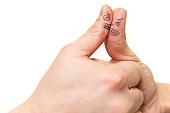
Home > Beginner Piano Lessons > Struggling With Proper Piano Fingering?
|
|||||
Do You Struggle With Proper Piano Fingering?
In every piano student’s mind, deep in some illogical, fear-driven cavern, there resides the notion that we alone in the history of piano playing might sustain some freak, inexplicable injury due to our pianistic incompetence. Or, not infrequently, watching our fingers slide around the piano uncontrollably crashing into notes reminds us of watching a three-legged horse on roller skates try to navigate down a slip’n’slide. Aspiring piano students need to know what constitutes proper piano fingering so that instead of sloppily thrashing, they can gracefully glide through difficult music passages. If we had one finger on each hand then we’d have no problem figuring out which one to use, plus we’d have incredibly boring music. The reason for finding the correct, best fingering for piano passages is to play smoothly, so that it doesn’t sound like you are an elephant mashing its trunk on the keys. One of the first approaches a student can take to learning proper piano fingering is to know your scales and the designated fingering for every single one. Scales are a great way to acclimate your fingers to the keys and reinforce the best ways to hit the notes. The more quickly and fluidly you can play scales, the more likely you are to have appropriate fingerings when play pieces too. Now, those black keys can be pesky: their positions make trouble when trying to squeeze fingers between them onto white keys or to play a passage that requires alacrity. Because these keys are positioned further away from your fingers than the white keys, it makes it especially difficult for your sympathetically shorter thumb to reach them.
While they may not be any law mandating specific fingers are used on specific notes during specific passages of specific songs, music editors thankfully give their advice. As you flip through various pieces you’ll notice the inconspicuous numbers written neatly above certain notes. Try these out. While no one would ever claim these are the “correct and only” fingers to use on these notes, they’re probably your best bet at playing a passage smoothly. Sometimes these fingerings may feel awkward at first. That’s okay – try them out, but don’t feel like some stuffy, glasses-wearing editor is frowning down on you if you decide a different fingering is better. In fact, everyone’s fingers are different, so it makes sense that certain fingerings suit performers differently. The real approach to finding the proper piano fingering is discovering through trial and error which fingerings are the best for your own hand. As long as you can play a passage accurately and smoothly – and as long as your fingers aren’t getting tied into knots – then your fingering choice is the correct one.
http://pianoplayerworld.com/PianoPlayingTips.html
| |||||
|
Although every attempt has been made to make information as accurate as possible, we are not responsible for any errors that may appear.
 Watching Bugs Bunny get his fingers tied into knots while playing Franz Liszt’s
Hungarian Rhapsody #2 makes us chuckle on the outside, but on the inside we piano players know that there is
some truth to the image.
Watching Bugs Bunny get his fingers tied into knots while playing Franz Liszt’s
Hungarian Rhapsody #2 makes us chuckle on the outside, but on the inside we piano players know that there is
some truth to the image.
 Some strict fingering experts declare that the thumb should never strike
a black key. Good for them, but this rule comes with its own complications too. A more seasoned performer
should concertedly restrain himself from overusing his thumb on black keys, but no strict rule could possibly
apply to all passages.
Some strict fingering experts declare that the thumb should never strike
a black key. Good for them, but this rule comes with its own complications too. A more seasoned performer
should concertedly restrain himself from overusing his thumb on black keys, but no strict rule could possibly
apply to all passages.



